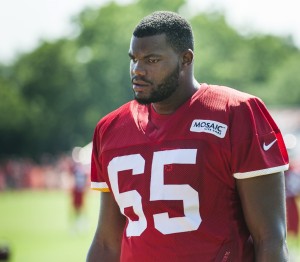The morning of Aug. 17, 2015 began much like the previous 11 training camp practices in St. Joseph, Mo.
Then-Chiefs offensive tackle Tavon Rooks joined his teammates on the field at Missouri Western State University and participated in stretching before breaking off for team drills.

Aug. 4, 2015; St. Joseph, MO; Chiefs offensive tackle Tavon Rooks (65) blocks linebacker Sage Harold (47) during training camp at Missouri Western State University. (AP Photo/Orlin Wagner)
While there was nothing unusual about the routine, Rooks soon discovered the day would prove far from normal.
The 25-year-old Rooks experienced pain in his chest during two-minute drills, but chose to ignore it.
“I knew something was wrong,” Rooks said in a telephone interview, “but I was like I’m going to fight through it because you’re trying to make the roster. Pain is not the first thing on your mind right now.”
The Kansas State product then experienced shortness of breath combined with chest pain while participating in one-on-one drills.
Rooks attempted to battle through the issues before realizing he no longer could ignore his deteriorating condition.
“After one-on-ones, that’s when I felt I needed help because I didn’t feel right,” he said. “It was to the point where I couldn’t focus on what I needed to do and accomplish on the field because there was discomfort in my chest.”
Rooks’ dilemma didn’t go unnoticed, as then-Chiefs guard Marcus Reed observed his friend and teammate kneeling on the sidelines.
“I asked if he could finish,” Reed said in a telephone interview. “He took a second to breathe and see what was going on and said he felt uncomfortable breathing.”
Reed took immediate action with his friend in obvious duress.
“I signaled a trainer over because at that point it’s serious,” Reed said. “You don’t want to hurt yourself trying to look good for the coaches even though you want to.”
The trainers brought Rooks to the medical tent, where a team physician, Dr. Michael Monaco, pulled up Rooks’ jersey and began checking him with a stethoscope.
After roughly 10 minutes outside, Rooks moved indoors, where he said team doctors attempted to alleviate the discomfort in his chest to no avail.
“I was scared,” Rooks said. “I never felt anything like that in my chest area. It was kind of scary to go through that, to have that happen to you because you wouldn’t think that would happen to you.”
The more harrowing moments were yet to come.
The Chiefs’ medical staff kept Rooks inside for a short period before deciding to rush him to the emergency room at nearby Mosaic Life Care hospital.
Upon his arrival, Rooks was taken to the catheter lab when he sensed his heart do something it never did before.
“I felt everything that happened in my heart — the rhythmic heartbeat or whatever the doctor was saying, I felt it,” Rooks said. “That’s when the nurse came in and asked me, ‘Did you feel your heart pump like that?’ And I said, ‘Yes.’”
Rooks said the Mosaic medical staff, led by Dr. Arvind Sharma, immediately prepped him for the insertion of a stent in an artery.
Only then did Rooks realize the true nature of his condition, which developed into a life-threatening situation.
******
Rooks was told he suffered acute myocardial infarction as a result of a thrombus – a blood clot – in the left anterior descending (LAD) artery.
“They officially called it a heart attack,” Rooks said. “I was scared. You don’t know what’s going to happen. You’ve been so healthy before, you don’t expect it to happen.”
He also dealt with what was described as a prolonged episode of ventricular tachycardia.
“Irregular heartbeat,” Rooks explained in layman’s terms. “If they didn’t catch that in time, the doctor was telling me I would’ve been dead on the field or in my dorm room that night.”
Numerous thoughts flooded his mind as medical staff members worked around him.
The 6-foot-5, 300-pound Rooks passed his preseason physical and entered training camp as a well-conditioned athlete with no known history of heart disease on his mother’s or father’s side of the family.
Tammy Moser, a registered respiratory therapist, didn’t treat Rooks. But she offered an opinion on a 25-year-old patient suffering a thrombus based on her area of expertise as the cardiac and pulmonary rehab coordinator at Geary Community Hospital in Junction City, Kan.
“Having a clot like that is not very common at all,” Moser said in a telephone interview. “It’s pretty rare, especially being young unless you have a very strong genetic history like his dad had a heart attack at a young age or grandfather had a heart attack at a young age, something like that. It’s pretty rare to have an actual heart attack at age 25.”
Still, healthy athletes suddenly developing a heart condition isn’t unheard of, evidenced by the high-profile deaths of Hank Gathers of Loyola Marymount and Reggie Lewis of the Boston Celtics.

Tavon Rooks, Molly Viger and their daughter, Londyn. (Courtesy of Molly Viger)
Rooks was fighting for his life and his mind focused on his family and girlfriend, Molly Viger.
But the hardest emotion for Rooks to stomach surrounded a father’s love for his daughter, Londyn, who celebrated her first birthday on Sept. 5.
“That probably hurt the most dealing with that whole situation,” Rooks said. “They said I could possibly die on the field. All that stuff was going through my head. I really wanted to get home and see my daughter smile again, hold her, just watch her grow up.”
The Mosaic Life Care medical staff succeeded in clearing the clot, and quick thinking by his former teammate to alert trainers and the Chiefs’ decision to get Rooks to the hospital proved life-saving measures.
Rooks’ agent, Richard Kopelman of KLASS Sports, is grateful for their collective actions.
“Odds are he would not have survived,” Kopelman said in a telephone interview. “It was really a very tenuous situation. We’re just so happy the Chiefs did what they did with Tavon in terms of the level of care he received from them, and then they got him into a good hospital with great care.”
Rooks spent five days at Mosaic Life Care, from Aug. 17 to 21, and endured the first two nights alone until Viger flew from Chandler, Ariz., to join him on Aug. 19.
The sight of Rooks hooked up to hospital machines proved overwhelming.
“It was kind of shocking,” Viger said in a telephone interview. “I’ve never seen him in that kind of situation. I’ve never seen him hurt or vulnerable. But I was happy he had someone there with him.”
Teammates flooded Rooks’ cellphone with text messages of concern and well wishes for recovery.
Members of the Chiefs staff, led by general manager John Dorsey, also took time to visit Rooks during his five-day stay in the hospital.
“That raised my spirits to have the GM come talk to you,” Rooks said. “It felt good. He’s a great guy. I’m glad I got the opportunity to see his face, shake his hand.”
Rooks said offensive line coach Andy Heck, assistant offensive line coach Eugene Chung, head athletic trainer Rick Burkholder, assistant trainer Evan Craft and player engagement manager B.J. Stabler stopped by at various times to cheer him up.
“They showed that they cared about me,” Rooks said. “I was very excited about that.”
******
Rooks and Viger returned to Arizona on Aug. 21, where he is currently under medication as part of his ongoing care and treatments to determine what prompted the initial episode.

Aug. 2, 2014; St. Joseph, MO: Chiefs offensive tackle Tavon Rooks between drills at training camp at Missouri Western State University. (Emily DeShazer/The Topeka Capital-Journal)
“Nobody knows what caused it, nobody knows what happened,” Rooks said. “They stopped it before it got any worse. I’ve got great doctors down here taking good care of me. We’re just working so we can help fight it.”
Out-of-state medical treatment meant Rooks wouldn’t be available for the remaining three preseason games and regular season, leaving the Chiefs with a decision as roster cuts loomed to set the initial 53-man roster.
The Chiefs eventually waived Rooks with a non-football illness designation on Sept. 1, which left him with a financial burden.
“I’ve had some discussions with the Chiefs in terms of if this truly turns out to be completely disconnected from football, a true non-football illness,” Kopelman said, “then they would actually absolutely under the collective bargaining agreement owe him nothing at all.”
And treatment won’t be cheap, according to Moser, the Geary Community Hospital respiratory therapist. Moser points out patients recovering from a blood clot episode are either on anticoagulant or an antiplatelet medication, while additional treatment adds to the expense.
“That’s usually given to them for several months depending on their history, so that’s pretty expensive,” Moser said. “And then the cost of all the tests that he’s going to have to undergo is also probably pretty expensive. I would say something like that, $30,000 to treat this right now.”
Rooks isn’t in a position to handle that hefty cost by himself given the current situation.
But while he is no longer a member of the team, the Chiefs stepped in to ensure Rooks wouldn’t incur the financial burden of continuing medical treatment.
“They’re making sure my hospital bills are paid for,” Rooks said. “They came down and helped me out with that because the NFL insurance expired already. For them to be willing to pay for that, I’m glad they did.”
His girlfriend agreed emphatically.
“It means they care more about him than just (as) a player,” Viger said. “They care about him as a person, so that means a lot.”
The Chiefs were contacted for this story, but a spokesman said the team couldn’t comment because of privacy regulations as outlined by the Health Insurance Portability and Accountability Act (HIPAA).
Nevertheless, Rooks’ agent isn’t surprised the Chiefs are going the extra mile based on past dealings with the organization.
“I think it’s above and beyond from what you typically see in professional sports, in the NFL,” Kopelman said. “But I don’t think it’s uncharacteristic of the Chiefs for folks like John Dorsey and others in that organization. I think it’s great.”
******
Rooks expressed his gratitude to the Mosaic Life Care medical staff, mentioning Dr. Sharma by name, and the Chiefs doctors and athletic trainers for helping save his life.

Tavon Rooks and Molly Viger celebrate Londyn’s birthday on Sept. 5, 2015. (Courtesy of Molly Viger)
He recently celebrated his daughter’s birthday with his girlfriend’s family in South Dakota and cherished every moment.
“I’m happy to wake up every day, see her beautiful smile, her laugh and giggle,” Rooks said. “I’m excited to wake up in the middle of the night just to hold her, sleep with her, because I love my daughter so much. I’m happy the Lord gave me a second chance at life.”
Rooks is on the road to recovery and now adjusts to a life without professional football, but the sport arguably played a role in ensuring he is alive today.
“I said to Tavon, there are guys that think football has destroyed their lives,” Kopelman said. “Football may have saved his life, as odd as it may be. If he had that same episode outside of football, he may not have lived to tell about it. That may sound like hyperbole, but it really isn’t.”
While Rooks admits he would enjoy continuing to play professional football, he has no regrets about playing a sport he loves.
Football, after all, took him from his hometown of Baltimore to Navarro Junior College to Kansas State, where Rooks earned a bachelor’s degree in general studies and met Viger.
Rooks also experienced hearing his name called as a sixth-round pick of the New Orleans Saints in the 2014 NFL Draft.
And then there are the Chiefs, a franchise he forever will hold in high regard.
“I love them,” Rooks said. “They are an A-1 organization. I’m glad I had a chance to play on the field with those guys, and they watched me and helped me to become better at life.”
His former teammate, Marcus Reed, just wants his friend to get healthy.
“You can have a great life without football,” Reed said. “Football isn’t everything if you’re not healthy. I hope he returns to great health and continues his dream, but if not, I hope he makes it through his condition.”
In the meantime, Rooks won’t be going through his journey alone when compared to the first two nights in the hospital.
He has his girlfriend and daughter at his side, and Viger is happy to have the family unit intact to face the challenge together.
“We just want him alive,” Viger said. “He doesn’t need to be a football player. He doesn’t need to be in the NFL. He just needs to be a dad right now.”
That scenario perfectly suits the former offensive lineman.
“Right now, I want to take care of my family,” Rooks said. “Make sure my daughter is fine and I’m healthy, so I can see my daughter grow up, go to her first prom and scare her boyfriend or something like that. That’s the only thing I’m worried about right now.”
———-
Herbie Teope is the lead Chiefs beat writer for ChiefsDigest.com and The Topeka Capital-Journal. Use the contact page to reach him or find him on Twitter: @HerbieTeope.
———-
